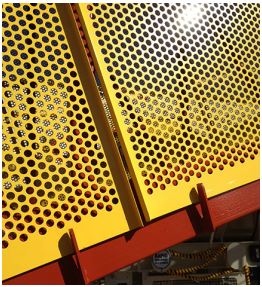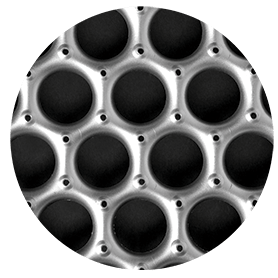Perforated tubes and other perforated products are widely used in a myriad of filtration, dampening, exhaust, drainage, and other industrial applications. Holes contained within perforated products are created using a combination of standard and/or custom punches, CNC punching pattern software, and special fabrication techniques. The size of the holes in the perforated tube or other product is typically determined by the application—for example, by the size of contaminants the tube must filter out.
Architectural Applications for Perforated Products
Due to their wide range of practical and aesthetic features, perforated metal is popular among architects and designers. You’ll find them being used in an array of applications, including:
- Lighting fixtures
- Conduit ducts
- Safety guards
Perforated metal is common as interior design elements, in which they allow light or air to be exchanged. They may also be used to dampen unwanted noise.
Choosing Perforated Metal Tubes for Your Application
Perforated tubes come in many different patterns. Ultimately, the design and application requirements will determine the perforation styles, or if the seams of the tubing contain perforations.
Metalex offers two primary seam designs for perforated spiral tubes: the flush (outside) and inside lock seam, which are popular for use in fluid filtration. We also offer a unique spiral louvered design with a flushed lock seam, used as an alternative to the straight seam tube when a weld is not required. Other seam designs include various welded and abutted options.
Perforated tubes come in an assortment of materials to meet the requirements of the specific application. Materials used in the manufacture of perforated tubing include:
- Tin plated
- Galvanized metal
- Stainless steel
- Brass
- Aluminum
The material will be application-specific based on the demands of the environment or the aesthetics required. For example, perforated tin plated metal tubes are common in filtration type applications, while perforated stainless steel, brass, and aluminum tubes are used as architectural elements.
Shapes
The types of hole shapes available in perforated products are limited only by the ability to machine cutting dies into a specific configuration that can create the shape and withstand the stresses of the punching process. Below are the most commonly used and most cost effective hole shapes:
 Round Holes. A round hole is the easiest and most economical shape to incorporate into perforated sheet metal, as the relative simplicity of machining a round piece results in low manufacturing costs. Round hole patterns are used in a variety of applications, including air-conditioning and heating systems and decorative finishes for architectural installations.
Round Holes. A round hole is the easiest and most economical shape to incorporate into perforated sheet metal, as the relative simplicity of machining a round piece results in low manufacturing costs. Round hole patterns are used in a variety of applications, including air-conditioning and heating systems and decorative finishes for architectural installations.
- Square Holes. Square holes provide a significant amount of open area and a clear view through finished sheets, while also offering a strong barrier that can be used to resist impact loads, prevent contact with equipment, or prevent entry of trespassers into protected areas. Increased wear on equipment occurs during the square hole perforation process due to the tendency of the punches to experience increased stresses near the corners of each square shape. For this reason, the creation of square hole patterns has increased costs over the production of round holes.
- Slot Holes. Slot holes consist of long rectangles with half-circle or square ends. These are versatile shapes in the manufacturing industry, as they are applicable to screening and sorting of materials—particularly long thin items such as seeds and grains. Slots can be installed parallel to either the width or the length of the sheet, depending on user preference and needs of the
Patterns
Straight line and staggered patterns represent the most common designs used for perforating metal. These fit the majority of perforated metal uses. Non-standard patterns are also available for custom applications.

- Straight Line. Straight-line perforated metal layouts consist of repeating rows that contain an identical number of holes in each row and follow the same alignment down the sheet as it is pulled through the punch. Straight patterns are designed by specifying both the distance between holes and the distance between successive rows of holes.
- Staggered Layouts. Staggered layouts consist of repeated patterns that offset alignments of adjacent rows as the sheets are pulled through the punch. Staggered layouts are specified based on the angle between centers of successive lines of holes. For instance, one of the most common patterns is a 60° staggered pattern. This means that after one row of holes is punched, the die moves over and punches the next row, so the line drawn from the center of a shape on the previous line to the center of an adjacent shape on the new line forms a 60° angle.
- Non-Standard. Non-standard patterns—such as circle, spiral, and star patterns—increase the cost of the perforation process, primarily as a result of the increased production time required to create these layouts. As with the hole shapes, utilization of patterns that are relatively symmetrical can reduce the overall cost of the perforated sheets.
Hole shapes and patterns have a sizeable impact on the cost and performance of your perforated product. Knowing these specifications helps eliminate roadblocks when you bring a project to a manufacturer. To learn more about the qualities of perforated products, download our free eBook, Proper Selection for Perforated Products.
Perforated Products from Metalex
Metalex was founded in 1962 and has grown from a small one-machine operation to a prominent member of a global group of manufacturers. We are dedicated to providing our customers with the highest quality products at the lowest possible cost. When you’re selecting perforated tubing for a particular application, our customer service representatives are available to offer advice on appropriate choices for any industry or application.
To learn more about our perforated products and how Metalex can help you achieve significant efficiencies and cost reductions in your operation, contact us or request a quote.








 Round Holes. A round hole is the easiest and most economical shape to incorporate into perforated sheet metal, as the relative simplicity of machining a round piece results in low manufacturing costs. Round hole patterns are used in a variety of applications, including air-conditioning and heating systems and decorative finishes for architectural installations.
Round Holes. A round hole is the easiest and most economical shape to incorporate into perforated sheet metal, as the relative simplicity of machining a round piece results in low manufacturing costs. Round hole patterns are used in a variety of applications, including air-conditioning and heating systems and decorative finishes for architectural installations.
Comments are closed